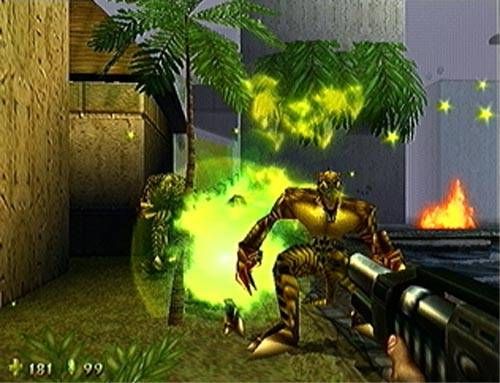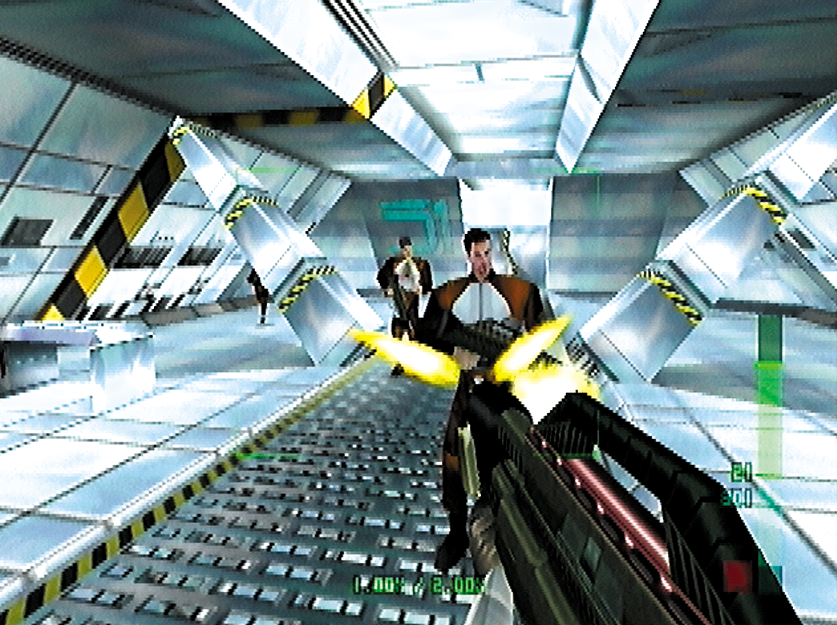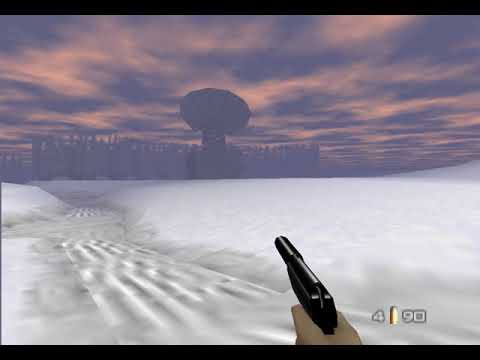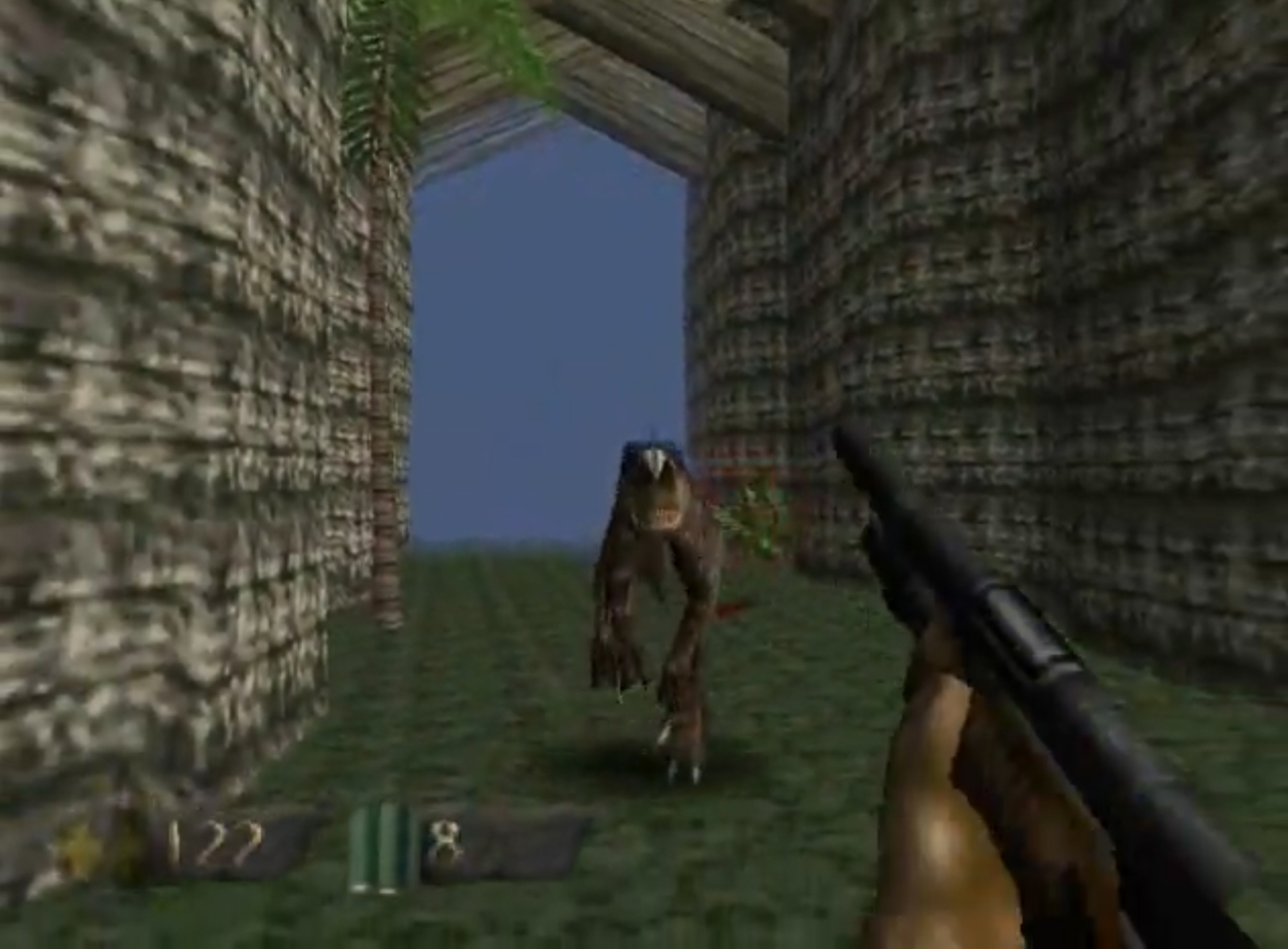The Nintendo 64 was the powerhouse of its time. It was, for the most part, the only machine between the Sony PlayStation and Sega Saturn that could do justice to the first-person shooting genre. Thus, the system was known for its great and numerous FPS experiences, even though the Nintendo 64 had an anemic lineup of third-party games.
Today, I have taken up the task of ranking the very best FPS on the system. My numerical order for ranking these games will consider both critical reception and my own personal preferences.
10. Forsaken 64 (1998)

Forsaken is not as popular as other entries on this list. The title sold about 290,000 copies (source: VGChartz). Consequently, few gamers got to experience the title on home consoles.
Unlike other titles on this list, Forsaken was not a Nintendo 64 exclusive title but a multiplatform one available on PlayStation and PC as well.
The Nintendo 64 version did slightly better critically than the PlayStation port in terms of critical reception (75 to PS’ 74), however, it was indeed at its best on PC (80/100 aggregator scores) with a 3D accelerator card.
The game served as a technical benchmark for early 3D cards on PC, and its technical prowess was widely praised by reviewers of the day.
As home console gamer, I preferred the Nintendo 64 version over the PlayStation due to its smoother visuals.
The game itself was mix of Descent and Quake, focusing heavily on maze like corridors which boded well for PlayStation gamers. However, it failed to impress me as a Nintendo 64 owner, since there were larger, better animated, and more realistic FPS experiences available on the system.
9. Quake (1998)

In may ways, Quake was an interesting first-person shooter. One of the interesting aspects about it is that a port of the game made it to the Sega Saturn but not to the PlayStation. An odd occurrence for a 1997-1998 release.
Built on Doom’s technology, an improvement over the aforementioned title, Quake was fully polygonal and a technical marvel on PC. Quake was also a source of discord in id Software as its development cycle caused most of its team to leave the company, including its co-founder, John Romero.
Quake’s storyline has the player fighting an alien enemy from a different dimension that is intent on invading earth. While this will seem like basic stuff these days, and indeed the plot was anemic, back in the mid 1990’s Quake was an atmospheric true sci-fi/dark fantasy tour de force on the Nintendo 64.
The Nintendo 64 version suffered some cutbacks which included a few missing single-player levels from the PC version and the lack of Co-op play. Instead, the Nintendo 64’s port did receive two player deathmatch modes and it is generally considered as the best home console version of the game.
8. Doom 64 (1997)

Contrary to what some may believe, Doom 64 is not a 64-bit version of the original Doom. It is instead a sequel to 1994’s Doom II.
The game’s storyline events take place directly after the series’ second entry. With our Doom Marine being sent to the UAC installations to put down another demon uprising.
Doom 64 was made from the ground up for the Nintendo 64 to take advantage of the hardware, making the game a superior version of doom to the previous PC entries. This is because before the introduction of 3D acceleration cards, the Nintendo 64 was the most powerful gaming machine on the market.
Doom 64 sold about 470,000 units on the Nintendo 64 worldwide, making the game a moderate success on the system and cult hit with Nintendo 64 gamers.
7. Quake II (1999)

Quake II is an improvement over the original Quake, not only in visuals but also in gameplay with larger levels, new abilities, and missions consisting of objectives. Golden Eye 007 had an influence on FPS games, even PC based ones like Quake.
Quake II was better received than its predecessor on the Nintendo 64 with an 81 GameRankings meta rating. While most people will not remember much of the single-player experience, Quake II did provide hours of thrills in its 4-player split screen multiplayer modes on the Nintendo 64.
Quake II made use of the N64’s Ram Pak to improve its lighting and overall visuals, making it the definite Quake II version over the PlayStation’s port.
6. Turok 3: Shadow of Oblivion (2000)

Turok’s 3rd entry on the Nintendo 64 is the less commercially successful game in the trilogy. It is also the lesser game despite featuring some of the best visuals that the Nintendo 64 has ever produced.
It is not that Turok 3 is that much worse than Turok 2 but that the formula had run its course by the time the third game was out. That said it remained an excellent title, having beautiful levels to explore and 2 playable characters with different abilities.
A robust multiplayer component did make Turok 3 a necessity for those looking for a great multiplayer experience on the system, providing a different feel from Golden Eye and Perfect Dark. With only 170,000 copies sold, Turok 3 was a commercial disappointment. The game had the misfortune of being released after Rareware’s juggernaut, Perfect Dark, which had taken the world by storm.
5. 007: The World is Not Enough (2000)

The World is Not Enough is not as good Golden Eye, not even close. That said, The World is Not Enough is as close as you could get within the James Bond license on the Nintendo 64. The game’s single-player structure follows the blueprint of Rare’s objective-based gameplay, but Bond can swim and dive underwater this time around.
The game felt a bit more linear than Rare’s take on the license, as the events were scripted and the enemy A.I. seemed to be dumbed down, contrasting the enemies in GE.
The game’s engine utilized the Ram Pak to craft colorful visuals and smooth framerates, but I still find it the uglier game when I stack it against Rare’s Golden Eye. The World is Not Enough’s other problem is that it was released after Perfect Dark, being an inferior product to Rare’s ultimate first-person shooter.
Despite this, and due to Golden Eye’s popularity on the machine, The World is Not Enough sold 1.5 million copies on the system, making the 4th most successful FPS on the Nintendo 64.
4. Turok 2: Seeds of Evil (1998)

The original Turok was a watershed moment for the Nintendo 64, and Turok 2 was an important game during a transitional time in console generations.
1998 was an important year for the Nintendo 64 with The Legend of Zelda: Ocarina of Time’s release on the holiday season, but by 1999 the Sega Dreamcast, a machine that was much more powerful than the N64 in every which way, loomed on the horizon.
Turok 2: Seeds of Evil was one of the first big name franchises for the N64 that would utilize the Ram Pak, which Nintendo billed as an upgrade that would keep its games from looking updated next to the Dreamcast’s batch of launch titles.
While I would not say that Turok 2 can compete with the Dreamcast’s best, as the gap in hardware power between the N64 (Ram Pak included) and the DC is too vast, Turok 2 did do a decent job in further separating the N64 from the PlayStation in terms of visual quality. I was incredibly pleased with the visuals that my little N64 was churning out; Turok 2 was impressive.
It was bigger than Turok: Dinosaur Hunter in every way. The draw distance was pushed out to significant effect because the game levels were large and multilayered. Improved enemy A.I. and Mario/Zelda inspired level design made Turok 2 a different game from the first one and one of the absolute best first-person shooting games of the 90s decade.
An 86 Metacritic score and 1.8 million units sold solidify Turok 2: Seeds of Evil status as one of the best Nintendo 64 games around.
3. Perfect Dark (2000)

By most accounts, Perfect Dark is a better game than Golden Eye. The problem with it, and the reason I rate the game lower than its spiritual predecessor, is that Perfect Dark in the year 2000 was nowhere near as revolutionary or as jaw-dropping as Golden Eye was in 1997.
Also, at some point with aging hardware, and the Nintendo 64 being quite old in the year 2000, over ambitious games tend suffer from well…over ambitions. While Perfect Dark had an amazing plot and bigger, prettier graphics than Golden Eye, the game had terrible framerate drops due to the improved visual fidelity. Even the mandatory use of the Ram Pak could not save the game from these issues.
Even with this glaring issue, the game was a massive hit with critics everywhere and continues to hold one of the highest Metacritic ratings ever with a staggering 97. Perfect Dark was also one of the swan songs for the Nintendo 64, selling 2.5 million units.
2. Turok: Dinosaur Hunter (1997)

For a brief moment in time (1996-Early 1997), Nintendo 64 owners had bragging rights over the PC “master race” and console “peasants” alike. They had the most powerful machine around, and a game like Turok: Dinosaur Hunter that was only possible on the hardware.
Turok, apart from being a terrific showcase of the hardware, was also a fairly good game to boot. In fact, it is my second favorite FPS of all time on the system. Yes, a lot of it is based on nostalgic memories, but few games have, before or since, impressed me as much as Turok did in early 1997 when I first engaged in the habit of Dinosaur shooting.
Turok provided for deep vertical level design, that ranged from high cliff exploration to deep underwater discoveries and its world begged to be explored in first person. While this might sound like heretic comments to some, it was a better game than Doom or Quake, both visually and in terms of gameplay.
Heck, even the fog that was meant to conceal pop-up issues added atmosphere to the game. My only complaint? It was a difficult game, and platform hopping felt like a test of faith (and luck), rather than one of skill.
But the above complaint might be the reason I feel that the game has aged so well in contrast to its contemporaries. It remains a difficult game that is worth a play in remastered form today.
1. Golden Eye 007 (1997)

Could there have been any other game in this slot? Golden Eye was revolutionary, but also provided a spark to the Nintendo 64 and Nintendo’s kiddie image. I am sure that a good chunk of the 32 million N64s that were sold were purchased by teenagers and young adults looking to play Golden Eye in college dorms with friends.
While Golden Eye is remembered by many for its revolutionary multiplayer thrills, it was critically acclaimed thanks to its equally revolutionary and polished single-player campaign, which deviated from the corridor formula that Doom had established into an objective based mission system which had sandbox components.
Apart from that, Golden Eye was a visually stunning masterpiece. No game looked better in 1997 and it remained one of the most realistic shooters around until the advent of Half-Life on PC. Even if you owned a PlayStation, the temptation to jump into Nintendo’s side of the fence was great with the advent of Rare’s shooter based on the James Bond license.
8 million gamers could not have been wrong, Golden Eye was a masterpiece of its time, and for many, the reason to own a Nintendo 64 and four controller pads to play with their family and friends. Golden Eye was the start of Rare’s historic run on the Nintendo 64. A run that they were never able to match under Microsoft, and a period considered as the developer’s golden age.
Agree with the author? Couldn’t disagree more and are frothing at the mouth to tell him? Leave a comment here, on Facebook or send an email and make sure to follow Never Ending Realm on Facebook, Twitter, and YouTube!
